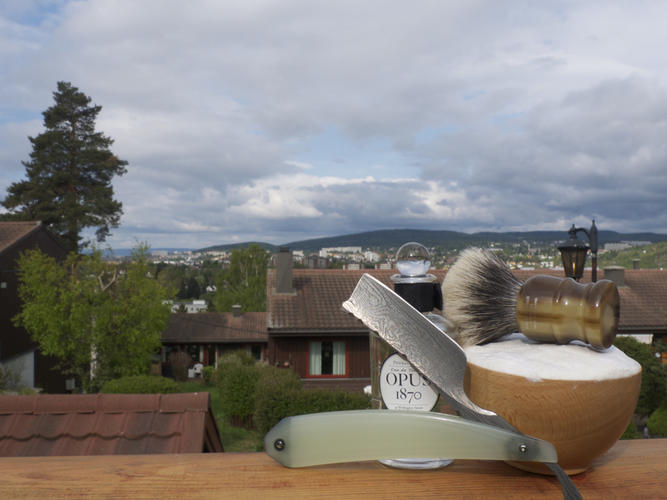Results 1 to 10 of 14
Thread: Damascus razor on ebay
-
06-07-2011, 05:42 AM #1Junior Member

- Join Date
- Nov 2010
- Posts
- 1
Thanked: 1 Damascus razor on ebay
Damascus razor on ebay
Hi All
I was surfing ebay and stumbeled upon this:
DAMAST MESSER RASIERMESSER KLINGE RASIERKLINGE HIRSCH | eBay
Has anyone tried these?
I did see the note saying:
"Note: Just a nice collector´s item with very sharp blade. But we can´t guaranty for shave."
But they could work. So again, anyone tried them, good or bad?
-
The Following User Says Thank You to Granit For This Useful Post:
Caledonian (06-07-2011)
-
06-07-2011, 05:48 AM #2This is not my actual head.



- Join Date
- Nov 2009
- Location
- Middle of nowhere, Minnesota
- Posts
- 4,624
- Blog Entries
- 2
Thanked: 1371
It wasn't that seller, but an eBay seller did send holli4pirating one of those inexpensive damascus razors to try out.
I believe it turned out to be a razor shaped object (RSO), but not anything useful as a razor.
Of course, the ones that seller offers may be different.
Strange women lying in ponds distributing swords is no basis for a system of government.
-
06-07-2011, 05:50 AM #3

If you have a search there is plenty of informaton here about these cheap "damascus" blades, heres one... http://straightrazorpalace.com/razor...cus-steel.html
-
06-07-2011, 05:51 AM #4

Generally Damascus and cheap don't exactly ever go together. I would be cautious and expect nothing but an ornament from any cheap damascus razor purchased on eBay.
-
06-07-2011, 10:53 AM #5

There is no reason why damascus (i.e laminated) steel) has needed to be used in a razor for the last century and a half or so. The best of it could, and the worst of it, which is commonly on the market nowadays, couldn't. It offers no advantage whatever over various homogeneous steels.
Old razors etched with "Damascus steel" (but showing no signs of laminated construction) are another matter. That, like "India steel", is just another way of saying "particularly good cutlery steel". It was meant to evoke memories of the time, then within living memory, when anything made with the little cakes of high-carbon steel which came via Damascus from India, really was better than the European article. But it wasn't true any more, even in mid-Victorian times.
-
06-07-2011, 11:06 AM #6
-
06-07-2011, 12:26 PM #7"My words are of iron..."


- Join Date
- Oct 2006
- Posts
- 1,898
Thanked: 995
I looked at the ad. Strike One: it's not twisted pattern as the ad states. Strike Two: despite listing two very good, common steels used in pattern welding, they admit it's Rockwell 52-53.
Strike Three: the person who buys this...“Nothing discloses real character like the use of power. Most people can bear adversity. But if you wish to know what a man really is, give him power.” R.G.Ingersoll
-
06-07-2011, 12:57 PM #8

... doesn't know what Rockwell 52-53 means?
Damascus or twist shotgun barrels are delightful enough to make my toes curl up, for they really did have a lot of point in their day, before near-liquid steel billets were hydraulically pressed to remove any seams or gaps. Even the best modern Damascus billets described as twist mostly don't show anything like their tight knotted pattern, although raindrop pattern may. The term Damascus in barrels was used only for the better grades in the English Midlands, and the quality descended through twist and Wednesbury skelp to such awful things as sham damn, for sale to ignorant savages who would mop up the blood and reflect that it was fine until a devil got into it.
Actually I don't think a technical tour de force with no practical purpose does look good, and few of the original users of laminated steel, in barrels or blades, used steels of different textures and etched it to make it piebald, with a texture you can feel. It had a far more subtle appearance. If it is a technical tour de force by whoever the maker bought his billet from (and clearly they have made the process a lot easier than cheaper than it used to be), it loses all point in my view.
-
06-08-2011, 08:38 PM #9

I never understood why guys are taking the time to make some very unique looking blades, but fail to make them into actual razors. Why not go the extra mile to make it ready to take the edge. Is it a matter of just heat treating the blade and grinding it properly or is there something else in the construction that prevents them from being shaving tools?
-
06-08-2011, 08:48 PM #10

I would assume that someone who makes blades that cannot be shaved with is more interested in the money than the sport. As a result, they will attempt maximize their profits. That means taking the cheapest route, which, typically, will not lead to a good product. It probably doesn't actually take them that much time to make the razors, given that they don't have to do so many of the things an actual razor-maker has to do in order to ensure the razor will shave. I am assuming, of course, that it is the making the razor shave well part that takes more time/effort/skill than the making a razor shaped object part.


 10Likes
10Likes LinkBack URL
LinkBack URL About LinkBacks
About LinkBacks






 Reply With Quote
Reply With Quote



